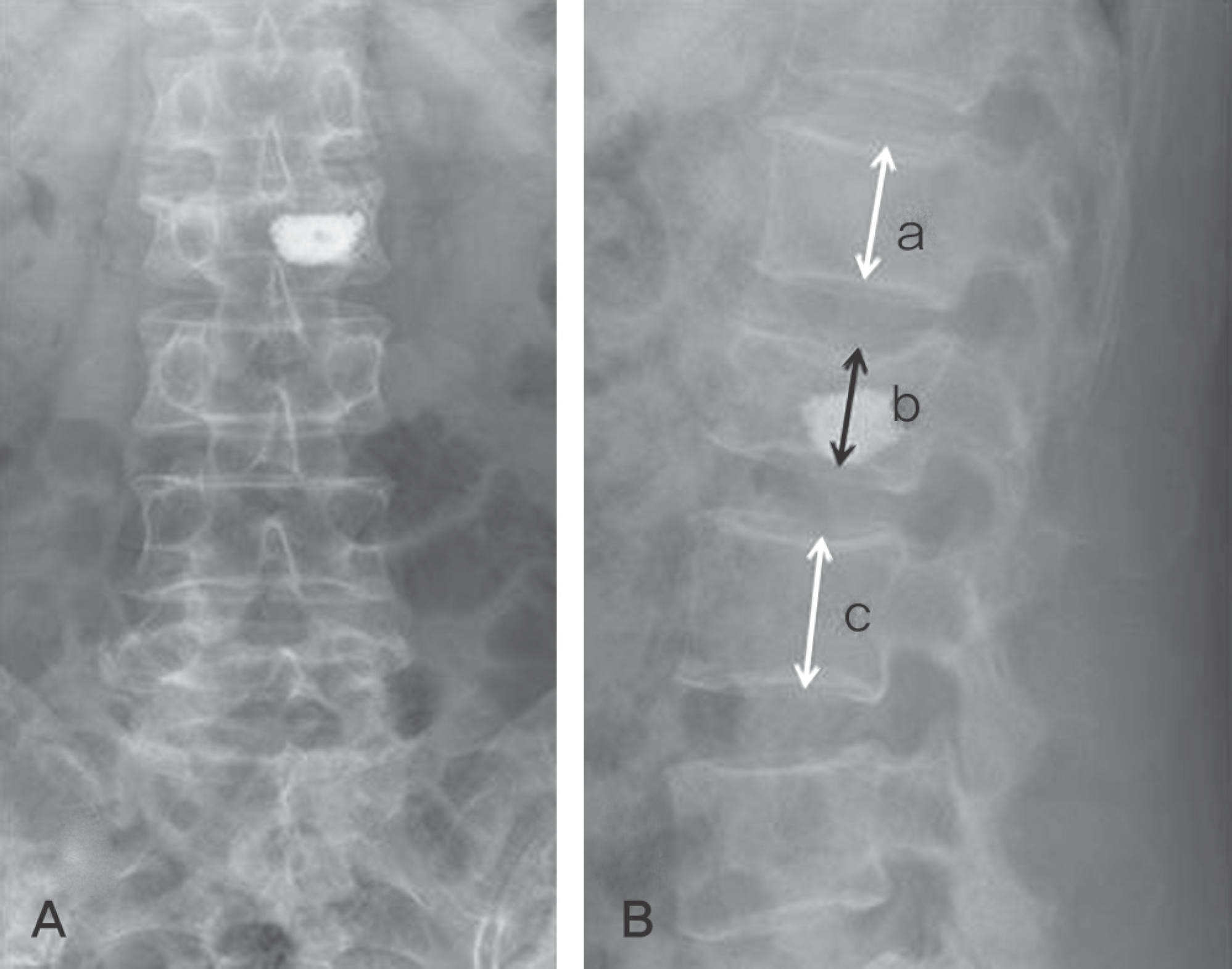Abstract
Objectives
We wanted to compare the clinical results of conventional vertebroplasty(VP) and the newly devised unilateral partial vertebroplasty(UPVP)\.
Summary of Literature Review
There has not been any study on how to reduce the amount of cement used while maintaining the height of the vertebral body and minimizing the adjacent compression fractures.
Materials and Methods
From 2004 to 2008, Group 1 underwent VP and group 2 underwent UPVP. We compared the difference of the VAS score, the period of hospitalization, the infused amount of cement, the progression of the vertebral body collapse and fresh fracture of the adjacent vertebral body on the followup simple radiographs.
Results
In group 1, the mean VAS score changed from 6.69 to 2.80, the mean period of hospitalization was 2.30 days and the mean amount of cement infused was 6.50cc. The degree of vertebral body collapse was 0.83, 0.76, 0.69 and 0.63 on followup, and 3 cases had fresh fracture. In group 2, the mean VAS score changed from 6.41 to 2.61, the mean period of hospitalization was 2.23 days and the mean amount of cement infused was 3.74cc. The degree of collapse was 0.71, 0.69, 0.68 and 0.63 on follow up and 1 case had fresh fracture. The two groups showed no statistical significance for the change of the VAS score and the period of hospitalization, and the amount of cement was significantly less in group 2. The degree of collapse was not significantly different on the 4 times of followup. The frequency of fresh fracture was significantly less in group 2.
REFERENCES
1. Cho YS, Cho SD, Kim BS, Park TW, Lew S, Hwang SY. Kummell's disease managed by percutaneous vertebroplasty. J Korean Soc Spine Surg. 2001; 8:226–34.

2. Lyles KW, Gold DT, Shipp KM, Pieper CF, Martinez S, Mulhausen PL. Association of Osteoporotic Vertebral Compression Fractures with Impaired Functional Status. Am J Med. 1993; 94:595–601.

4. Hasegawa K, Abe M, Washio T, Hara T. An Experimental Study on the Interface Strength between Titanium Mesh Cage and Vertebra in Reference to Vertebral Bone Mineral Density. Spine (Phila Pa 1976). 2001; 26:957–63.

5. Lotz JC, Hu SS, Chiu DF, Yu M, Colliou O, Poser RD. Carbonated Apatite Cement Augmentation of Pedicle Screw Fixation in the Lumbar Spine. Spine (Phila Pa 1976). 1997; 22:2716–23.

6. Moore D, Maitra R, Farjo L, Graziano G, Goldstein S. Restoration of Pedicle Screw Fixation with an in situ setting Calcium Phosphate Cement. Spine (Phila Pa 1976). 1997; 22:1696–705.

7. Ryu KS, Park CK. A Management for Osteoporotic Bursting Fractures of the Thoracic and Lumbar Spines in the Aged: Posterior Approach with Intraoperative Vertebroplasty. J Korean Neurosurg Soc. 2003; 33:259–63.
8. Kim CH, Choi YJ, Hwang JK, Kim KH, Lee JH, Song JS. Long term outcome of Vertebroplasty in the Treatment of Osteoporotic Compression Fracture. J Korean Soc Spine Surg. 2005; 12:69–74.

9. Deramond H, Depriester C, Galibert P, Le Gars D. Percutaneous Vertebroplasty with Polymethylmethacrylate. Technique, indications, and results. Radiol Clin North Am. 1998; 36:533–46.
10. Liebschner MA, Rosenberg WS, Keaveny TM. Effects of Bone Cement Volume and Distribution on Vertebral Stiffness after Vertebroplasty. Spine (Phila Pa 1976). 2001; 26:1547–54.

11. Belkoff S, Deramond H, Mathis J, Jasper L. Vertebroplasty: The Biomechanical Effect of Cement Volume. Trans Orthop Res Soc. 2000; 46:356.
12. Song JC, Bak KH, Cho DC. Hong HJ, Kim JM, Kim CH. The Effect of Early Percutaneous Vertebroplasty in Occult Osteoporotic Vertebral Fracture. Korean J spine. 2008; 5:173–7.
13. Fleiss JL, Coheni J. The Equivalence of Weighted Kappa and the Intraclass Correlation Coefficient as Measures of Reliability. Educ Psychol Meas. 1973; 33:613–9.

14. Kim BJ, Kim JH, Seo JG, Kim YC. Comparison of the Results of Percutaneous Vertebroplasty for Treating Osteoporotic Vertebral Compression Fracture and Posttraumatic Vertebral Collapse (Kummell's disease). J Korean Soc Spine Surg. 2005; 12:349–57.

15. Chen LH, Lai PL, Chen WJ. Unipedicle Percutaneous Vertebroplasty for Spinal Intraosseous Vacuum Cleft. Clin Orthop Relat Res. 2005; 435:148–53.

16. Galibert P, Deramond H, Rosat P, Le Gars D. Preliminary Note on the Treatment of Vertebral Angioma by Percutaneous Acrylic Vertebroplasty. Neurochirurgie. 1987; 33:166–8.
17. Sjö strö m L, Karlströ m G, Pech P, Rauschning W. Indirect Spinal Canal Decompression in Burst Fractures Treated with Pedicle Screw Instrumentation. Spine (Phila Pa 1976). 1996; 21:113–23.
18. Genant HK, Wu CY, van Kuijk C, Nevitt MC. Vertebral Fracture Assessment using a Semiquantitative Technique. J Bone Miner Res. 1993; 8:1137–48.

19. Heini PF, Berlemann U, Kaufmann M, Lippuner K, Fankhauser C, van Landuyt P. Augmentation of Mechanical Properties in Osteoporotic Vertebral Bones–a Biomechanical Investigation of Vertebroplasty Efficacy with Different Bone Cements. Eur Spine J. 2001; 10:164–71.
20. White AA, Panjabi MM. Clinical Biomechanics of the Spine. 2nd ed.Philadelphia: Lippincott;1990.
21. Belkoff SM, Maroney M, Fenton DC, Mathis JM. An in vitro Biomechanical Evaluation of Bone used in Percutaneous Vertebroplasty. Bone. 1999; 25:23–6.




 PDF
PDF ePub
ePub Citation
Citation Print
Print



 XML Download
XML Download